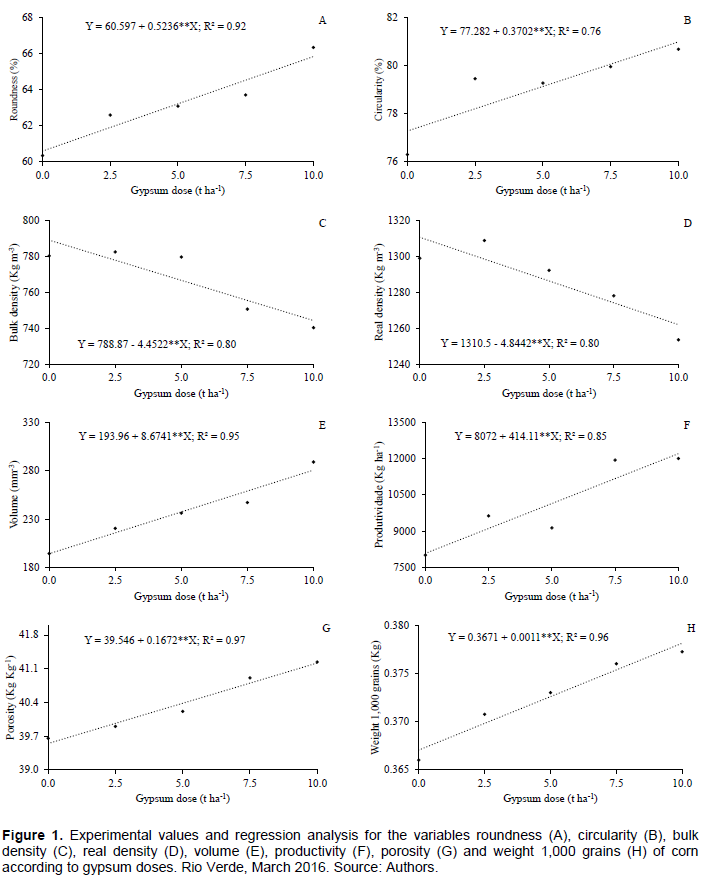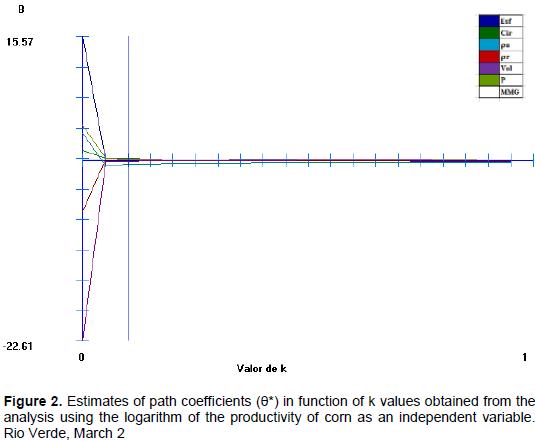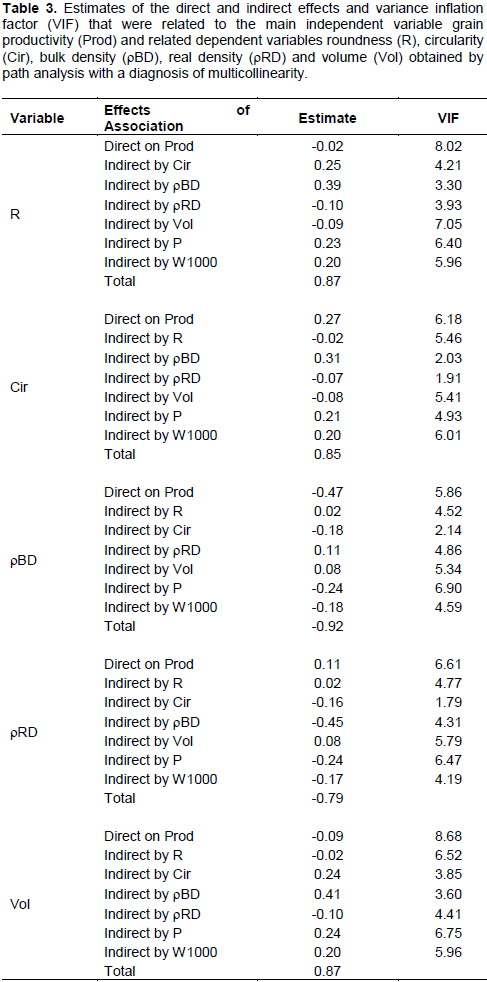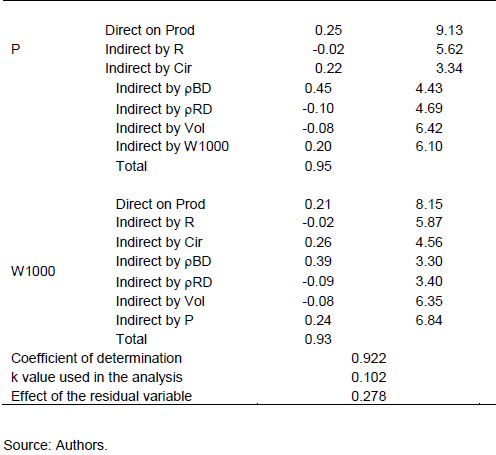ABSTRACT
The productivity of corn grains is directly associated with factors related to soil fertility, which are relevant to the application of gypsum (calcium sulphate), in addition to variables inherent to the grain. Thus, the objective of this study was to evaluate the variability of the physical properties of grains (circularity, roundness, bulk density, real density, volume and porosity) and production components (productivity and weight of 1,000 grains) of corn irrigated with increasing doses of gypsum, and evaluate the effects of direct and indirect associations of physical properties of grains and weight of 1,000 grains on grain productivity. The soil of the experiment was a Dystrophic Red Latosol. The experiment was conducted using a random blocks design. An analysis of variance by F test and a univariate regression analysis were performed regarding the relations among culture variables with different doses of gypsum (0.0, 2.5, 5.0, 7.5 and 10 t ha-1). An analysis of variance by t test was also performed together with a multivariate analysis using a path analysis with multicollinearity in order to analyze the direct and indirect effects of the physical properties of grains and weight of 1,000 grains on productivity. The bulk density of the grains had a direct effect on productivity of corn grains. In addition, the decrease in bulk density in function of the increase of gypsum doses is attributed to a greater increase in porosity in relation to weight of 1,000 grains.
Key words: Zea mays L., calcium sulphate, path analysis, bulk density.
Corn (Zea mays L.) is regarded as a basic component of the human diet. It is highly demanded in the production of animal feed because of its high energy content (Coradi et al., 2011). In the 2015/2016 harvest, however, the productivity in Brazil was 4% below average with respect to last season (Conab, 2016). Therefore, it is necessary that production systems be improved considering various factors aiming to an increased productivity. In view of the various factors that negatively affect the productivity of corn, agricultural gypsum is used to overcome problems related to low productivity because gypsum is considered a soil conditioner providing a greater absorption of water and nutrients by plants mainly at deeper soil layers (Sousa et al., 1996).
Productivity is a complex parameter and depends directly or indirectly on the association between different biotic and abiotic factors and different components of the plant structure itself (Carvalho et al., 1999). Thus, the degree of such associations obtained by correlation studies allows identifying variables that affect productivity. Some physical properties of the grains are important in the cause and effect mechanism related to productivity. Yet, their determination is relevant at various stages of beneficiation, equipment sizing, handling, transportation, drying and storage processes (Gürsoy and Güzel, 2010). Specifically, the shape and size of grains are extremely important for the control and automation of processing equipment and post-harvest equipment (Nunes et al., 2014; Pereira et al., 2014).The unfolding of correlations developed by Wright (1921), called path analysis, allows a better understanding of the causes involved in associations of parameters, where correlations are estimated as direct and indirect effects of explanatory variables on the dependent variable.
For path coefficients to be reliable and generate a biologically correct interpretation, a multicollinearity diagnostic should be made (Cruz and Carneiro, 2003). In the presence of moderate to severe multicollinearity, path coefficients may reach values too high. Therefore, in order to correct this problem, an alternative approach to the least squares, that is, ridge path analysis, should be used (Carvalho, 1995).The objective of this study was to evaluate the variability of the physical properties of grains (circularity, roundness, bulk density, real density, volume and porosity) and production components (productivity and weight of 1,000 grains) of corn irrigated with increasing doses of gypsum, and evaluate the effects of direct and indirect associations of physical properties of grains and weight of 1,000 grains on grain productivity.
Data were obtained from an experimental research conducted at Brazil, at an experimental area of the Goiano Federal Institute, campus Rio Verde (17°48' S, 50°54' W; altitude 744 m), during the agricultural year 2014/2015.The climate is classified as Aw, tropical with an average annual temperature of 21°C, 1,500-1,800 mm rainfall and relative humidity at 30 to 85% (Sectec, Rio Verde City Hall).The soil of the experimental area is classified as a dystroferric Red Latosol, with a dense, medium texture (Santos et al., 2013). Soil preparation was performed with a disc plow and a leveling tractor. The main chemical characteristics analyzed, according to the methodology described by EMBRAPA (2006), and the physical characteristics are shown in Table 1. Sowing and coverage fertilizations were performed according to soil analysis and the recommendation by Sousa and Lobato (2004). A drip irrigation system was adopted, which was managed by a digital puncture tensiometer with a sensitivity of 1 kPa. Tensiometric rods were installed 20 cm deep and spaced 15 cm from the drip line in three series. Thus, a voltage limit of 50 kPa was considered, keeping 100% of the available water capacity in the soil (AWC).

The experimental plots were distributed in a randomized blocks design with five doses of gypsum (0, 2.5, 5.0, 7.5 and 10 t ha-1) in five blocks (replications). Each plot was composed of 8 lines 4.0 meters (m) long with a 0.45 m spacing between rows. The use area of the plot consisted of 4 central rows 2.0 m long, totaling 3.6 m2. The gypsum was manually applied to the surface, keeping a most uniform application, at 45 days after plant emergence. To determine the proper harvest time, the water content was determined using an electric capacitance determiner until the level was suitable for harvesting (the proper level was 14.5% on a wet basis). After the manual harvest of hybrid corn (P 4285 YH) realized in July 6, 2016 totaling 120 days of cultivation, the physical properties of the grains (volume, circularity, roundness, bulk density, real density and porosity), weight of 1,000 grains and grain productivity were analyzed.15 corn grains per treatment were used (Oliveira et al., 2014) to determine the volume in m3 (Equation 1), circularity in % (Equation 2) and roundness in % (Equation 3) according to Mohsenin (1986). The measurements were taken using a digital caliper with a 0.01 mm resolution, where a = bigger axis of the grain, in mm; b - average axis of the grain, in mm; c - smaller axis of the grain, in mm.

The bulk density was determined using a Hectoliter Weight (PH) BK 4001 scale, and was expressed in kg m-3. The real density (rr) was determined by the ratio between the mass (kg) and the volume (m3) of the grain according to Mohsenin (1986).The porosity of the granular corn mass was determined indirectly using an air comparison pycnometer built by the Department of Postharvest of the Goiano Federal Institute, campus Rio Verde, using the average of five replications per gypsum treatment according to the procedure described by Mohsenin (1986).The productivity was obtained from the manual harvest of the four 2 m central rows. After threshed, corn grains (Kg), in known area units, were extrapolated to kg ha-1. At the same time, 1,000 grains were separated per experimental unit and the weight of 1,000 grains was determined. Initially, an analysis of variance (P < 0.05) was performed. When there was a significant effect, the polynomial regression linear of the culture variables was adjusted according to gypsum doses. A diagnosis of multicollinearity and the multicollinearity of the singular matrix X'X, based on the condition number (CN), which is the ratio between the highest and lowest eigenvalue of the matrix, were performed. A NC < 100 means a weak multicollinearity and does not constitute a problem for the analysis; 100<NC<1,000 means an average to strong multicollinearity, and NC>1,000 means a severe multicollinearity (Cruz and Carneiro, 2003).Subsequently, a path analysis with multicollinearity was performed according to Wright (1921) in order to adjust the k value and unfold the phenotypic correlations into direct and indirect effects of variables of the physical properties of the grains on productivity. The variance inflation factor (VIF) was also determined. All statistical analyses were performed using the software Genes (Cruz, 2013).
There was a significant effect of the variables roundness (R), circularity (Cir), bulk density (rBD), real density (rRD), volume (Vol), porosity (P), weigh of 1,000 grains (W1000) and productivity (Prod), which shows a variability among gypsum doses. The coefficients of variation were low: 0.24 to 1.35% (Table 2). Figure 1 shows the linear adjustment of culture variables evaluated in function of gypsum doses. Thus, the positive linear regression was adjusted for roundness, circularity, volume, productivity, porosity and weight of 1,000 grains (Figure 1A, B, E, F, G and H) with an estimated increase of 0.79, 0.46, 3.09, 3.39, 0.41 and 0.29%, respectively, by one-unit dose increase of gypsum. The negative linear regression was adjusted for bulk density and real density (Figure 1C and D), resulting in a reduction of 0.59 and 0.38%, respectively, by unit increase in the gypsum dose. Several studies found a positive effect of the application of gypsum on corn productivity. Some particularities were highlighted by Blum et al. (2013), who found that the positive effects of such application on corn productivity are associated with Ca2+ and SO42- contents in the soil. Caires et al. (2011) found a significant relation between the productivity of corn and exchangeable Ca2+ contents in the soil even after nine years, and concluded that the observed differences in productivity, with respect to gypsum, may be related to the absorption of Ca2+ by plant roots due to cation exchange.


Caires et al. (2004), studying soil chemical changes and corn response to liming and the application of gypsum, found that gypsum improved the chemical characteristics of the soil in depth. An increase in Ca2+ and SO42- in the soil and in N, K and Ca in the leaves of corn was observed, thereby increasing productivity. Importantly, the biological fixation of air nitrogen by Azospirillum depends on the concentration of S. Even in the absence of S, there is no N2 fixation in corn. According to the authors, this is because the source of H2 results from water vapor from root respiration by the action of ferredoxin containing sulfur (Vitti et al., 2015).Since gypsum provides a greater absorption of nutrients and water by the plant (Souza and Lobato, 2004), the increase in the physical properties of the grains in function of the increase in gypsum doses is attributed to a greater increase in water content in relation to photoassimilates. This is proven by porosity showing an increase (0.41%) higher than the weight of 1,000 grains (0.29%), which is linked to a decrease in the bulk density of grains due to an increase in gypsum doses. The increases in drying air temperatures,
associated with the decrease of water levels, lead to reductions in length, width, thickness, volume, circularity and roundness of corn grains (Coradi et al., 2016).
Since there was variability for gypsum doses, the path analysis revealed a severe multicollinearity for the inverse matrix of independent variables (determinant of the matrix X'X = 1.36 x 10-4, and number of condition (NC) = 184,399.26). According to Montgomery and Peck (1981), the multicollinearity is more intense as the determinant of the correlation matrix between the variables approaches zero. To circumvent the effects of multicollinearity, the path of the K ridge was adjusted in the inverse diagonal matrix and the value (0.1021) was used to decrease the variable inflation factor (VIF) (Figure 2).The estimator in ridge (θ*) is a biased estimator, according to Hoerl and Kennard (1970). For Kalil (1977), the K-value may vary depending on the choice of the researcher being based on subjective criteria. The K-value, according to Carvalho (1995), should also be able to stabilize most path coefficients estimators, and this choice should be based on the lowest value.

The unfolding of estimated correlations into direct and indirect effects of the variables of grains (physical properties) on grain productivity is shown in Table 3.The direct correlation of bulk density with grain productivity is well associated because the simple correlation coefficient (r) (-0.92) and the direct effect (-0.47) are similar in magnitude and equal in signal considering any other combination (Table 3), indicating that the bulk density has the highest direct effect on productivity.


Because bulk density has a greater importance in the association with productivity, it is attributed to smaller increases of weight of 1,000 grains and to larger increases in porosity due to the increase of gypsum doses, as shown by the univariate analysis.For the variables roundness and volume, it was found that the correlation is caused by indirect effects because the RD is positive and the direct effect is near zero or negative. Thus, these variables associate indirectly with a greater grain productivity by bulk density. These are the situations that presented the highest correlation estimates (Table 3). In all correlations, VIFs presented values below 10, which indicates that the equations of the diagonal of the inverse matrix are well estimated by multicollinearity. All regression models in the multivariate analysis expressed a high reliability because the coefficient of determination for the variables was 92.2%.
The bulk density of the grains had a direct effect on the productivity of corn grains. In addition, the decrease in bulk density in function of the increase in gypsum doses is attributed to a greater increase in porosity in relation to the weight of 1,000 grains.
The authors have not declared any conflict of interests.
REFERENCES
|
Blum SC, Caires EF, Alleoni LRF (2013). Lime and phosphor gypsum application and sulfate retention in subtropical soils under no-till system. J. Soil Sci. Plant Nutr. Temuco 13:279-300.
|
|
|
|
Caires EF, Joris HAW, Churka S (2011). Long-term effects of lime and gypsum additions on notill corn and soybean yield and soil chemical properties in southern Brazil, Soil Use and Management 27:45-53.
Crossref
|
|
|
|
Caires EF, Kusman MT, Barth G, Garbuio FJ, Padilha JM (2004). Alterações químicas do solo e resposta do milho à calagem e aplicação de gesso. Rev. Bras. Ciênc. Solo 28:125-136.
Crossref
|
|
|
|
Carvalho CGP de, Oliveira VR, Cruz CD, Casali VWD (1999). Análise de trilha sob multicolinearidade em pimentão. Pesquisa Agropecuária Brasileira. Brasília. 34(4):603-613.
|
|
|
|
Carvalho SP de (1995). Métodos alternativos de estimação de coeficientes de trilha e índices de seleção, sob multicolinearidade. Viçosa: UFV 163 p.
|
|
|
|
Conab - Companhia Nacional de Abastecimento. (2016). Acompanhamento da safra brasileira de grãos. 9 ed. Brasília: Conab.
|
|
|
|
Coradi PC, Lacerda Filho AF de, Melo EC (2011). Quality of raw materials from different regions of Minas Gerais State utilized in ration industry. Rev. Bras. de Engenharia Agríc. Ambient. 15(1):424-431.
|
|
|
|
Coradi PC, Milane LV, Andrade MGO, Camilo LJ, Souza AHS (2016). Secagem de grãos de milho do cerrado em um secador comercial de fluxos mistos. Braz. J. Biosyst. Eng. 10(1):14-26.
|
|
|
|
Cruz CD (2013). Genes - a software package for analysis in experimental statistics and quantitative genetics. Acta Scientiarum - Agron. Maringá 35(3):271-276.
|
|
|
|
Cruz CD, Carneiro PCS (2003). Modelos biométricos aplicados ao melhoramento genético. Viçosa: UFV 585 p.
|
|
|
|
Embrapa - Empresa Brasileira de Pesquisa Agropecuária (2006). Sistema brasileiro de classificação de solos. Centro Nacional de Pesquisa de Solos. Rio de Janeiro. RJ; Embrapa Solos 306 p.
|
|
|
|
Gürsoy S, Güzel E (2010) Determination of Physical Properties of Some Agricultural Grains. Res. J. Appl. Sci. Eng. Technol. 2(5):492-498.
|
|
|
|
Hoerl AE, Kennard RW (1970) Ridge regression: biased estimation for nonorthogonal problems. Technometrics 12(1):55-68.
Crossref
|
|
|
|
Kalil MN (1977). Aplicação do método de regressão de cumeeira ("ridge regression") na estimação de funções de demanda e de produção. Piracicaba: USP-ESALQ 135p.
|
|
|
|
Mohsenin NN (1986). Physical properties of plant and animal materials. New York: Gordon and Breach Publishers 841 p.
|
|
|
|
Montgomery DC, Peck EA (1981). Introduction to linear regression analysis. New York: J. Wiley 504 p.
|
|
|
|
Nunes JAS, Ormond AT, Caneppele C, Silva SLS da, Job MT (2014). Determinação do ângulo de repouso, volume unitário, eixos ortogonais e esfericidade de trigo. Acta Iguazu. Cascavel 3(2):77-86.
|
|
|
|
Oliveira DEC de, Santos MNS dos, Rufatto S (2014). Forma e tamanho dos grãos de milho da cultivar P3646 submetidos a diferentes condições de ar de secagem. Nativa. Sinop 2(3):162-165.
|
|
|
|
Pereira MTJ, Caneppele C, Silva SLS, Nunes JAS, Ormond ATS (2014). Propriedades físicas de marcas comerciais de milho pipoca: grão e estourada. Enciclopédia Biosfera 10(18):2525-2532.
|
|
|
|
Santos HG, dos Jacomine PKT, Anjos LHC dos, Oliveira VA de, Lumbrelas JF, Coelho MR, Almeida JA de, Cunha TJF, Oliveira JB De (2013). Sistema Brasileiro de Classificação de Solos. 3 ed. Brasília, DF: Embrapa 353 p.
|
|
|
|
Sousa DMG, Lobato E (2004). Calagem e adubação para culturas anuais e semiperenes. In: Sousa, D.M.G. Lobato E (Eds.). Cerrado. correção do solo e adubação. 2.ed. Brasília: Embrapa. pp. 283-315.
|
|
|
|
Sousa DMG, Lobato E, Rein TA (1996). Uso do gesso agrícola nos solos dos Cerrados. Planaltina: Embrapa/CPAC. (Embrapa/ CPAC. Circular Técnica 32:20. Vitti GC, Zavaschi E, Moura TA de, Gomes MHF (2015). Estudos confirmam efeitos favoráveis do gesso agrícola à cultura do milho. Brasília: Embrapa/CPAC. Embrapa/CPAC. Circular Técnica 13:51.
|
|
|
|
Wright S (1921). Correlation and causation. J. Agric. Res. 20:557-585.
|